Hops in Beer Brewing: Blato
Published: October 11, 2025 at 8:17:39 AM UTC
Blato, a Czech aroma hop variety, hails from the hop-growing region that once supplied Czechoslovakia. Known as Bohemian Early Red, it is part of the Saaz family. This hop variety is celebrated for its soft, noble-hop profile, which brewers highly value.
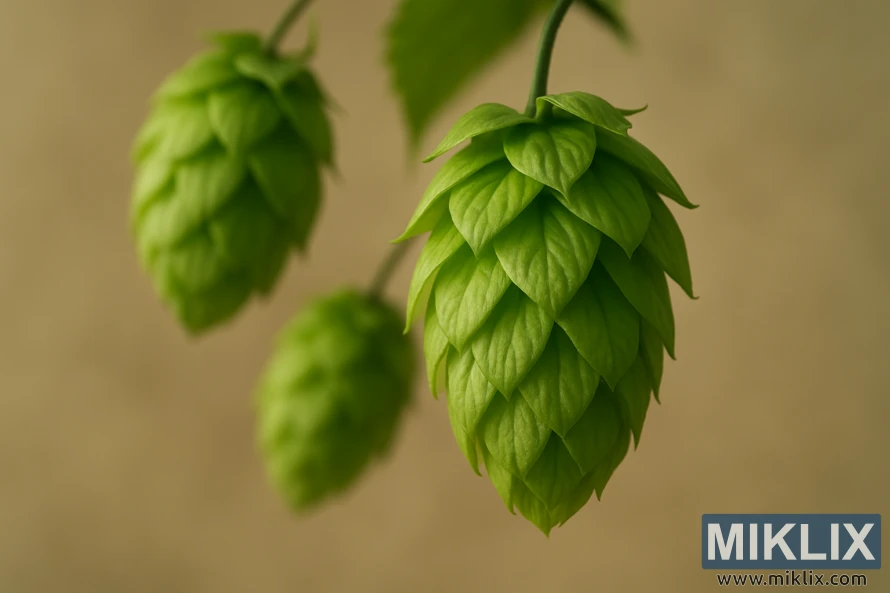
Blato hops are mainly used for their aromatic qualities. They excel in late additions, whirlpool rests, and dry hopping. This allows their subtle spice and floral notes to enhance the beer's flavor. Their delicate character makes them perfect for lager and pilsner styles. They are also ideal for super-premium beers that require a refined, authentic Czech hop signature.
Brewers and researchers often refer to the Žatec Hop Company and USDA hop chemistry records when discussing Blato. For U.S. brewers interested in Czech hops, Blato provides a classic Saaz-like option. It serves a clear aromatic purpose in brewing.
Key Takeaways
- Blato hop variety is a Czech aroma hop historically authorized early for commercial production.
- It is commonly grouped with Saaz hops and known as Bohemian Early Red.
- Primary use is aroma: late additions, whirlpool, and dry hopping.
- Best suited to lagers, pilsners, and super-premium beers seeking a noble-hop character.
- Primary references include the Žatec Hop Company and USDA hop chemistry records.
Introduction to Blato hops
The roots of Blato hops lie in the Czech Republic, where it was first cleared for commercial use during the Czechoslovak era. In Žatec and nearby areas, brewers and growers documented its early cultivation. This solidified its place among the esteemed Czech hop varieties.
Blato is often viewed as part of the Saaz family, rather than a distinct, heavily promoted cultivar. The Zatec Hop Company highlights that Blato shares the delicate, restrained aroma typical of the Saaz family. It also brings the classic perfumed notes that brewers seek in Bohemian hops.
In brewing, Blato is preferred for those aiming at traditional lager and pilsner profiles. Its subtle spice and floral notes complement delicate malt bills and soft water profiles. These are common in Bohemian-style beers.
- Origins: historic Czech hop growing areas and early authorization for production.
- Aromatic profile: aligned with Saaz family traits—gentle, noble, and refined.
- Use case: favored for lagers and pilsners that need authentic Bohemian hops character.
Botanical and agronomic profile of Blato
Blato exhibits a compact, delicate habit reminiscent of Saaz-type hops. Its cones are small with a fine density, ideal for traditional lagers. Handling these cones reveals their fragility.
In the United States, field trials have shown Blato's hop growth rate to be lower than in its native Czechia. It thrives best in its traditional Czechia sites, where climate and soil align with its origins.
The average hop yield for Blato is about 670 kg per hectare, or roughly 600 lbs per acre. This places it in the lower-to-moderate category for commercial hop production.
Observations indicate moderate susceptibility to downy mildew. Growers must implement an active spray and canopy program during wet springs to safeguard developing shoots.
Storability data reveal Blato retains approximately 65% of its alpha acids after six months at 20°C (68°F). This retention affects supply planning for brewers who prioritize consistent alpha content.
- Preferred regions: traditional Czechia sites.
- Performance in U.S.: generally poor in trials.
- Yield benchmark: ~670 kg/ha.
- Disease note: moderate downy mildew susceptibility.
For agronomists and growers, achieving balance is key. This involves managing the lower hop growth rate and modest yield with careful disease management and timely harvest. It maximizes cone density and quality in commercial lots.
Chemical composition and oil profile
Blato's chemical makeup reveals a moderate alpha range, centered at 4.5%. This makes it ideal for subtle bittering and balanced aroma work. Lab reports and industry summaries consistently list Blato alpha acids at about 4.5% while beta acids sit near 3.5% in most samples.
Co-humulone accounts for roughly 21% of total alpha acids. This proportion helps predict perceived bitterness when brewers rely on Blato for kettle additions. The moderate alpha level gives control without overwhelming malt character in lagers and pale ales.
Total oil content is low, about 0.65 mL per 100 g. This low oil figure aligns with a traditional noble profile. It supports clean, restrained hop expression rather than intense tropical or citrus punch.
The hop oil profile breaks down with myrcene near 47%, humulene around 18%, caryophyllene about 5%, and farnesene at roughly 11.2%. These proportions give a clear picture of Blato’s aromatic footprint.
High myrcene delivers soft, green, and resinous top notes. Humulene and farnesene contribute light herbal and floral accents that suit pilsners and classic lagers. Caryophyllene adds a subtle spicy depth without dominating.
When formulating recipes, use the combined data on Blato chemical composition and oil proportions to balance bittering and aroma goals. The profile favors restrained, elegant beers where nuance matters more than punchy hop character.
Aroma and flavor characteristics for brewing
Blato aroma is characterized by a gentle, noble hop scent, distinct from sharp tropical or citrus notes. Brewers at Žatec and independent labs describe it as having an understated scent. This scent combines earthy floral herbal tones with a mild spice, making it ideal for achieving a refined topnote.
The Blato flavor profile begins with soft earthiness, followed by subtle floral lifts. Herbal nuances emerge on the finish, imparting a classic Saaz-like character. Late additions preserve these delicate layers, ensuring they don't overpower malt or yeast-derived flavors.
It's commonly used in whirlpool and dry-hop treatments to maintain a clear yet restrained noble hop aroma. Small dosages enhance the elegance of pilsners, classic lagers, and restrained pale ales. The hop also supports balance and complexity, adding earthy floral herbal accents to blends.
- Primary descriptors: earthy, floral, herbal, mild.
- Best use: late addition, whirlpool, dry hop.
- Styles suited: traditional lagers, Belgian ales, gentle pale ales.
Blind trials confirm Blato aroma's compatibility with Saaz and other noble varieties. Its flavor profile pairs well with noble hop blends and Saaz-type hop additions. Brewers seeking finesse should focus on timing and use low-to-moderate dosages to preserve the hop's subtle charm.
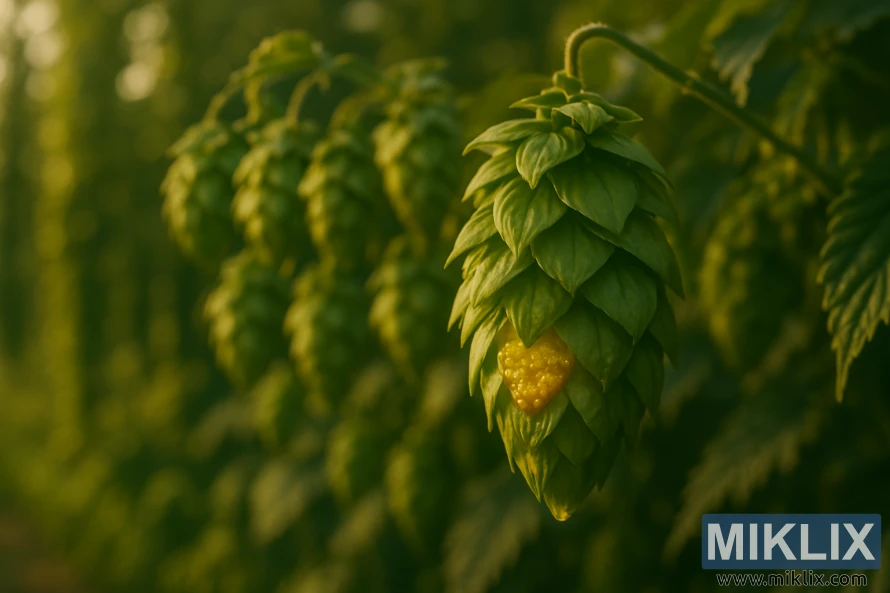
Common beer styles that showcase Blato
Blato hops are a perfect fit for clean lager recipes. They're chosen for Czech-style pilsners, adding subtle spice and floral notes without overpowering bitterness. This gives the beer a polished, old-world charm.
European lagers, like Vienna and Märzen, benefit from Blato's subtle profile. They gain a noble touch, enhancing the malt-forward character with a soft, harmonious hop presence.
Lighter ales can also benefit from Blato, aiming for elegance over boldness. Kölsch and Czech-style ales welcome small amounts of lager aroma hops. This elevates the nose while keeping the palate crisp, showcasing delicate hop nuances.
- Pilsners: primary showcase for Blato beer styles, specially Czech pilsners.
- Classic European lagers: Vienna lager, Märzen and similar malt-led beers.
- Clean ales: Kölsch and Czech-style ales using lager aroma hops sparingly.
- Super-premium lagers: beers where subtlety and refinement matter most.
For brewers seeking balance, add Blato late in the boil or as a light dry hop. This approach highlights the lager aroma hops, keeping bitterness in check. Small additions ensure the hop's nuanced scent is preserved in high-end, malt-forward beers.
Brewing uses: bittering vs aroma vs dry hopping
Blato is highly valued for its aroma, not its bittering power. With alpha acids around 4.5%, it falls short as a primary bittering hop. To achieve a robust bitterness, brewers often combine it with higher-alpha varieties like Magnum or Warrior.
For optimal aroma, add Blato in the last 10 minutes of the boil. This method preserves volatile oils, enhancing floral, herbal, and noble-like scents. Steeping hops at 170–185°F extracts the aroma without the harshness of polyphenols.
Dry hopping with Blato reveals its delicate scents in the finished beer. Expect soft floral and earthy notes, rather than bold resin or citrus. Use it sparingly to add a subtle lift to lagers, pilsners, or classic ales.
Blending strategies can enhance Blato's aroma use. Start with a neutral bittering hop early, then reserve Blato for late additions and dry hopping. This approach preserves its nuanced profile while maintaining beer balance.
- Primary bittering: pair with a high-alpha hop for backbone.
- Late hop additions: last 10 minutes or whirlpool for aroma.
- Dry hop Blato: gentle floral and herbal lift, avoid heavy resin blends.
When dry hopping Blato, adjust contact time and temperature. Shorter contact times preserve freshness, while longer times deepen earthy tones. Regular tasting will help you find the perfect balance for your recipe.
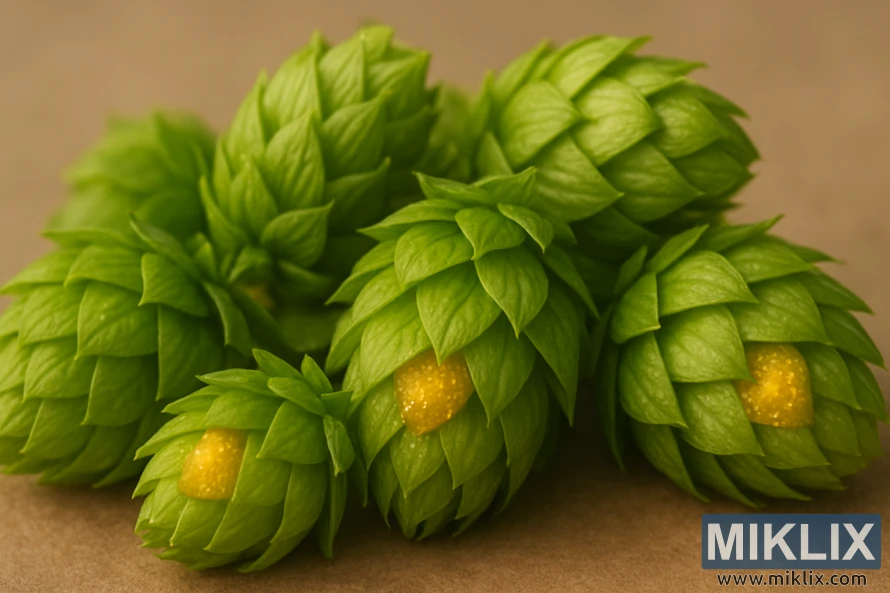
Recipe guidance and typical dosage
Blato's alpha acid content is around 4.5%, making it perfect for adding aroma without bitterness. Use Blato recipe guidance to add most hops late in the boil, in the whirlpool, or as dry hops. This approach enhances floral and noble notes.
For 5-gallon (19-L) batches, start with 0.5–1.0 oz (14–28 g) of Blato for late-boil or whirlpool additions. Add another 0.5–1.0 oz (14–28 g) for dry hopping. These amounts provide a subtle noble character. For a stronger aroma, increase the quantities.
Aggregated recipe data indicates Blato often makes up half of the hop bill when it's the focus. In pilsners and lagers, it occupies 26% to 55% of the total hop mass. This showcases its role in these beers.
Follow an ordered approach for scaling and balance:
- Assign bittering to a higher-alpha variety like Magnum or Warrior to hit target IBUs.
- Reserve 40–60% of total hop mass for late additions and dry hop when highlighting Blato.
- Adjust hopping rates upward if the malt bill is light or if the beer will be served fresh and cold.
Commercial brewers should scale by target IBUs and aroma percentage. Aim for Blato to represent about half of the total hop mass when it's the signature aroma. Keep hop rates Blato aligned with calculated IBUs from other bittering hops.
For pilsners and classic lagers, use Blato recipe guidance to emphasize restraint. In ales, increase late additions and dry hop amounts. This makes the floral profile more obvious without raising bitterness.
Monitor results and iterate. Small changes in Blato dosage can significantly alter the beer's character. Track hopping rates, keep accurate records, and tweak additions across batches. This ensures the desired aroma intensity and balance.
Substitutes and pairing hops for Blato
Blato fills the Saaz-type niche in European brewing. Finding exact Blato substitutes is challenging. Brewers often turn to classic Saaz varieties like Saaz conventional or Žatecký poloraný červeňák. These hops offer similar herbal, spicy, and noble-earthy notes.
For hop pairings that maintain Blato's delicate profile, opt for neutral or noble-type hops. Hallertau Mittelfrüh, Tettnang, and Spalt are excellent choices. They add subtle floral lift without overpowering the core aroma.
- Use Saaz substitutes in late additions and whirlpool to emulate that soft spice and straw character.
- Combine Blato or its substitutes with Hallertau Mittelfrüh for a rounded noble bouquet.
- Try Spalt in small percentages to boost herbal depth while keeping clarity.
When crafting a recipe, a bittering backbone is essential. Pair Blato blends with higher-alpha hops for this. Early boil additions of Magnum or Nugget provide stable IBUs. This approach keeps bitterness separate from the delicate aroma, ensuring Blato's signature notes shine through.
Recipe crafting demands balance. Use modest amounts of Saaz substitutes in dry hop and aroma stages. Reserve Magnum or Nugget for bittering. This strategy preserves the nuance in Blato blends while achieving the desired bitterness and stability.
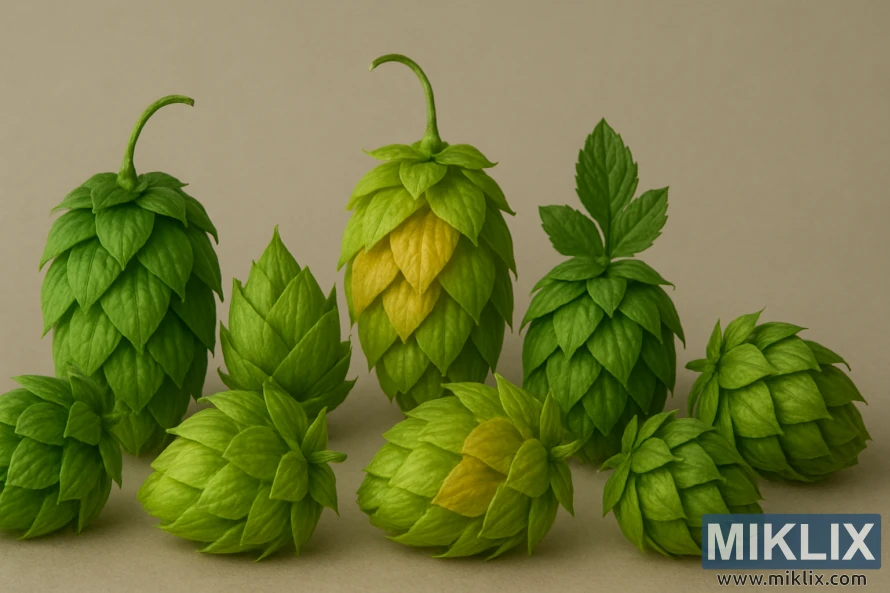
Growing and sourcing Blato for U.S. brewers
Blato thrives in the Czech microclimate. U.S. trials have shown poor yields, making careful site selection and patience crucial for growing Blato in the U.S. American farms often experience low trellis vigor and sparse cone set, unlike Czech fields.
U.S. breweries seeking authentic Blato turn to Czech suppliers. The Zatec Hop Company offers oil and resin profiles that match heritage Blato. This makes Czech hops import the most reliable option for consistency. Expect limited lots and higher pricing for small quantities.
Plan your procurement well in advance. For single-batch trials, collaborate with hop brokers or specialist importers to secure small lots. They handle phytosanitary paperwork and customs clearance, reducing delays and compliance risks during Czech hops import.
- Check harvest timing and storage practices before purchase.
- Request lab analysis to confirm alpha acids and oil composition from Zatec Hop Company or other Czech labs.
- Budget for freight and import fees when sourcing Blato hops.
Consider hybrid approaches for recipe development. Use imported Blato for aroma and small-batch signature beers. Then, test U.S.-grown material for scale if trials improve. Keep records of yield, cone quality, and brewing outcomes to guide future growing Blato USA efforts.
Documentation is key. Verify phytosanitary certificates and coordinate with USDA-APHIS requirements when arranging Czech hops import. Proper paperwork speeds customs clearance and protects the supply chain for craft brewers sourcing Blato hops.
Storage, alpha retention, and quality control
Proper Blato storage begins with maintaining low temperatures and limiting oxygen exposure. Hops should be vacuum-sealed and stored in refrigerated or frozen conditions. This slows down the degradation of volatile oils.
At around 20°C (68°F), Blato retains about 65% of its alpha acid after six months. This shows why the storage temperature is crucial for brewers. It ensures consistent bittering power and aroma.
To track hop alpha retention, request certificates of analysis from suppliers. These certificates provide baseline values for alpha acids and total oils before storage.
- Use gas chromatography or third-party lab testing to verify oil profiles.
- Measure myrcene, humulene, and farnesene to confirm aromatic integrity.
- Record dates, temperatures, and vacuum-seal integrity for each batch.
Blato's value is mainly in its aroma. Preserving volatile oils requires strict quality control and cold chain management. This is essential from the supplier to the brew house.
Regular, small checks can significantly reduce risks. Periodic lab assays and visual inspections help identify issues early. This ensures consistent aroma contribution across brews.
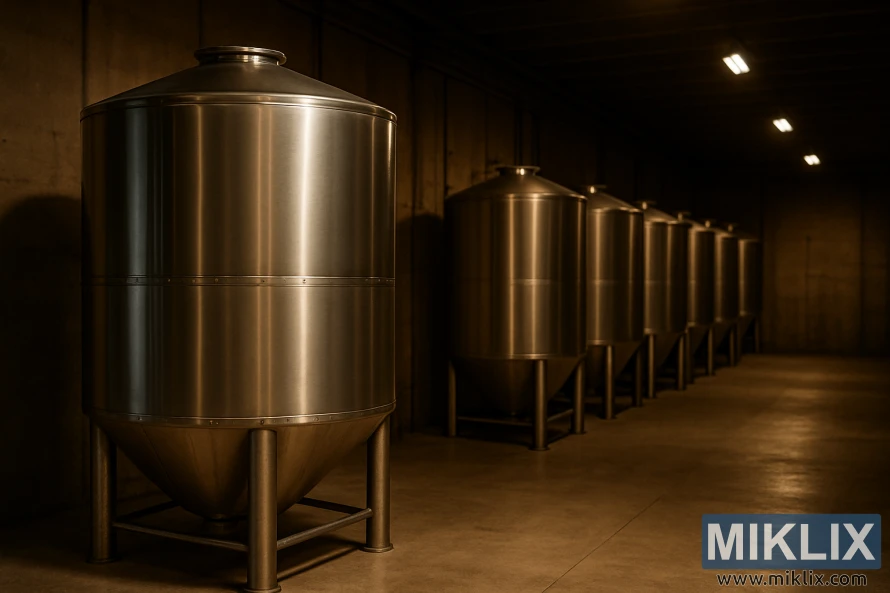
Blato in recipe case studies and examples
Beer-Analytics data reveals Blato's limited presence in recipes. Only three recipes were found where Blato is used mainly for aroma. This Blato case study shows it's typically added late or as a dry hop. This preserves the delicate floral and herbal notes.
In a Czech-style pilsner recipe, Blato makes up half of the late hop additions. It's paired with neutral hops like Magnum or Hallertau Mittelfrüh. This combination builds structure while showcasing Blato's noble character.
For a small-batch lager, allocate 50% of late additions to Blato. Use a clean lager yeast like Wyeast 2124 Bohemian Lager or White Labs WLP830 German Lager. Avoid heavy malt adjuncts and strong hop-forward dry hopping to preserve subtle notes.
- Example 1: Czech pilsner — base pils malt, 10–12 IBU from neutral bittering hops, 50% late additions as Blato for aroma.
- Example 2: Golden lager — moderate bitterness, Blato as primary dry hop at 1–2 g/L to add herbal top notes.
- Example 3: Hybrid pale lager — blend Blato with Saaz for added complexity while keeping overall hop load restrained.
The Blato case study supports late-use strategies. In small batches, add Blato late in the boil and during whirlpool at low temperature. This preserves volatiles. A short, cool dry hop can boost aroma without extracting harsh vegetal compounds.
These examples highlight Blato's performance in subtle recipes. Clean fermentation, measured bitterness, and a late-addition focus produce pilsner and lager recipes. They emphasize noble, Saaz-like qualities.
Market perception and popularity trends
Blato is a known member of the Saaz/Bohemian family but its market presence is limited. In the United States, craft brewers often prefer more abundant Saaz varieties over Blato due to its lower yield. This preference is driven by the need for reliable, high-yielding hops.
Specialty hop merchants and Czech growers keep Blato in the spotlight for those seeking genuine noble-hop essence. Its rarity solidifies its niche status, where authenticity and historical significance outweigh widespread availability.
The interest in classic pilsner profiles, as seen in Saaz market trends, keeps Blato relevant for premium lagers. Small, heritage-focused breweries in the U.S. seek it out for recipes needing precise Bohemian aroma and spice.
Supply constraints, mainly due to low yields outside central Europe, limit Blato's broader adoption. Despite growing demand for unique and traditional flavors in craft brewing, its scarcity hinders wider use. Brewers weigh cost, availability, and stylistic goals when considering Blato.
Blato is typically sourced through specialist suppliers, hop brokers, and direct Czech export channels. Brewers who value site-specific authenticity see Blato as a deliberate choice, not a default ingredient.
- Appeal: high among traditional pilsner brewers and niche hops collectors.
- Visibility: concentrated with specialists and Czech producers.
- Adoption: limited in the U.S. due to climate and yield challenges.
Technical reference data and lab analysis
Zatec Hop Company, Beer-Analytics summaries, and USDA hop records provide a unified technical profile for brewers and scientists. Alpha acid is consistently at 4.5%, with beta acid around 3.5% in most reports. Co-humulone is noted at 21%, and total oil at 0.65 mL per 100 g.
The essential oil analysis of Blato hops reveals myrcene as the dominant component, making up about 47%. Humulene is near 18%, caryophyllene around 5%, and farnesene at 11.2%. These figures explain the hop's mild citrus and herbal notes in beer.
Yield and agronomic data support planning for both craft and commercial production. The average yield is 670 kg/ha, or roughly 600 lbs per acre. Storage stability tests show Blato retains about 65% of alpha acid after six months at 20°C (68°F).
For researchers comparing varieties, the hop chemistry metrics in USDA hop records and independent lab reports standardize formulations. Brewers can use these numbers for bitterness calculations, oil-driven aroma balancing, and shelf-life expectations.
- Alpha acid: 4.5%
- Beta acid: ~3.5% (industry consensus)
- Co-humulone: 21%
- Total oil: 0.65 mL/100 g
- Oil breakdown: Myrcene 47%, Humulene 18%, Caryophyllene 5%, Farnesene 11.2%
- Yield: 670 kg/ha (600 lbs/acre)
- Storage stability: ~65% alpha after 6 months at 20°C (68°F)
When precise batch-level adjustments are needed, reference datasets like Blato hop analysis and USDA hop records are essential. Lab-to-lab variance exists, so running a local assay is advisable for critical brews.
Conclusion
Blato summary: This classic Czech Saaz-family hop is perfect for lagers, pilsners, and delicate ales. It has a low alpha (around 4.5%) and modest total oil (≈0.65 mL/100g). This makes Blato ideal for aroma rather than aggressive bittering. Brewers looking for subtle herbal and floral notes will appreciate Blato, best used late in the boil or in whirlpool additions.
When using Blato hops, pair them with a higher-alpha bittering hop to manage IBUs. This approach preserves the hop's subtlety. Dry hopping or brief whirlpool contact showcases the noble character without the green or vegetal notes. Blato brewing tips include measuring alpha contributions carefully and keeping contact times short. This maintains clarity and balance in traditional Czech-style beers.
U.S. brewers should be aware of the limited domestic supply and lower yields from trial cultivation. Sourcing from Czech suppliers ensures authenticity. Store hops cold, dry, and oxygen-free to protect fragile oils. This Czech hops conclusion highlights the use of Blato for a reserved, elegant hop presence, rather than bold citrus or resin tones.
Further Reading
If you enjoyed this post, you may also like these suggestions:
